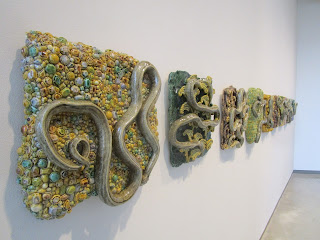The Daum Museum of Contemporary Art opened in 2002 and is located on the State Fair Community College campus in Sedalia, Missouri. The Daum features a diverse permanent collection and offers three exhibition cycles each year and up to 15 exhibitions. The museum includes nine exhibition galleries on three levels with a combined area of 9,300 square feet.
The heart of the Daum is the permanent collection comprised of abstract paintings, drawings, prints, ceramics, and sculpture created since the mid-20th century. The museum’s namesake, Dr. Harold F. Daum, a retired radiologist and avid art collector, gave life to the museum by donating his 300-piece art collection and funds toward its construction. The permanent collection has grown to over 1,500 objects through gifts and selected purchases. It features significant works by Andy Warhol, Ed Ruscha, Helen Frankenthaler, Robert Motherwell, Peter Voulkos, Betty Woodman, Louise Bourgeois, Linda Connor, and Ansel Adams.
The National Council on Education for the Ceramic Arts (NCECA) is a dynamic, 501(c)3 organization that engages and sustains a community for ceramic art, teaching and learning. In addition to deepening knowledge within the field, NCECA expands it by working to cultivate the next generation of ceramic artists and enthusiasts through programing that affects professional artists, K-12 schools, community centers, universities, museums, galleries, businesses, organizations, collectors and enthusiasts of ceramic art.
This year, NCECA will celebrate is 50th annual conference which will be held in Kansas City, March 16-19.
The 50th Anniversary Conference of the National Council on Education for the Ceramic Arts will explore the personal, social and aesthetic forces that animate creative work with elemental materials, methods and ideas in the midst of the information age. Kansas City, Missouri, the geographical epicenter of the continental US, will host this years conference.
With Kansas City so close to Sedalia, it just made sense for the Daum to show off some of its selections from the collection as well as recent American Ceramics from the Dr. Harold F. Daum Collection.
Highlights of the collection include iconic examples by artists associated with the generation that reinvigorated American ceramics after World War II, including Peter Voulkos, Rudy Autio, John Mason, Ken Ferguson, Karen Karnes, and Ruth Duckworth. Artists of the following generation include Chris Gustin, Peter Callas, John Balistreri, and Arnold Zimmerman. Ceramists interested in a conceptual art practice are represented by Betty Woodman, Raymon Elozua, Anne Currier, Marc Leuthold, and Tony Marsh. Audience-engaging story telling is found in sculptures by Sergei Isupov, Michael Lucero, Arthur Gonzalez, and Sun-Koo Yuh.
An important segment of the Daum’s holdings is comprised by the many ceramists who live and work in the Midwest, including Jim Leedy, Jun Kaneko, Victor Babu, Cary Esser, George Timmock, Yoshiro Ikeda, Joyce Jablonski, and Keith Ekstam. Among the artists in the collection who live outside the United States are Carlo Zauli, Ole Lislerud, Ah Leon, and Wouter Dam.



















































